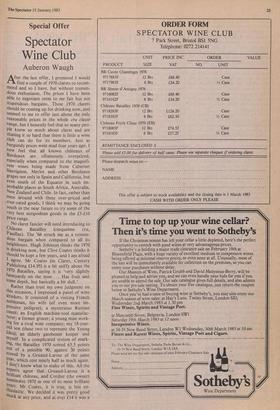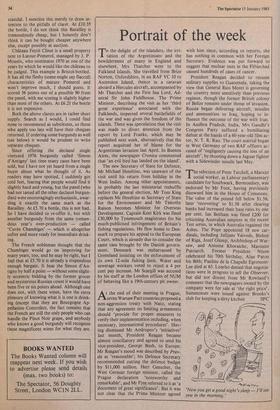Special Offer
Spectator Wine Club
Auberon Waugh
Ater the last offer, I promised I would find a couple of 1970 clarets to recom- mend and so I have, but without tremen- dous enthusiasm. The prices I have been able to negotiate seem to me fair but not stupendous bargains. These 1970 clarets should be coming up for drinking now, and seemed to me to offer just about the only reasonable prices in the whole cru classe range, but I honestly feel that so many peo- ple know so much about claret and are chasing it so hard that there is little a wine club can do for its members. Just as burgundy prices went mad four years ago, I now feel that all known châteaux of Bordeaux are villainously overpriced, especially when compared to the magnifi- cent wines being made from Cabernet Sauvignon, Merlot and other Bordeaux grapes not only in Spain and California, but even south of the Equator in such im- probable places as South Africa, Australia, New Zealand and Chile. In fact, rather than Mess around with these over-priced and over-rated goods, I think we may be going south in the near future to try some of the very best antipodean goods in the f5-.£10 Price range.
No claret fancier will need introducing to Château Batailley (cinquienne cru, Pauillac). The '66 struck me as a tremen- dous bargain when compared to all its neighbours. Hugh Johnson thinks the 1970 is drinking now, but Clive Coates thinks it should be kept a few years, and I am afraid 1 agree. Mr Coates (in Claret, Century Publishing £14.95) is a bit sniffy about the 1970 Batailley, saying it is 'very slightly farmyardy on the nose ... Has fruit and some depth, but basically a bit dull.' Rather than trust my own judgment on this occasion, I impressed a panel of wine drinkers. It consisted of a visiting French nobleman, his wife (of even more im- pressive pedigree); a mysterious Russian Count; an English machine-tool manufac- turer; a former grocer; a young man work- ing for a rival wine company; my 18-year- old son (these two to represent the Young Idea); an elderly gatehouse keeper and inYself. In a complicated system of mark- ing, the Batailley 1970 scored 63.5 points out of a possible 90, against 30 points scored by a Gruaud-Larose of the same Year, which cost nearly half as much again. 1 don't know what to make of this. All the experts agree that Gruaud-Larose is a brilliant château, and Cordier (the owner) nominates 1970 as one of its most brilliant Years. Mr Coates, it is true, is less en- thusiastic. We decided it was pretty good Muck at any price, and at over 14 it was a
scandal. I mention this merely to draw at- tention to the pitfalls of claret. At £10.35 the bottle, I do not think this Batailley is tremendously cheap, but I honestly don't think it can be bought cheaper anywhere else, except possibly at auction.
Château Feytit Clinet is a small property next to Latour-Pomerol, managed by J. P. Moueix, who nominates 1970 as one of the years by which he would like the château to be judged. This example is Bristol-bottled. It has all the fleshy (some might say flaccid) characteristics of mature Pomerol and won't improve much, I should guess. It scored 56 points out of a possible 90 from the panel, with me scoring it slightly higher than most of the others. At £6.21 the bottle it is not expensive.
Both the above clarets are in rather short supply. Search as I would, I could find none to recommend as substitutes, so those who apply too late will have their cheques returned. If ordering some burgundy as well (see below) it would be prudent to write separate cheques.
Since offering the declasse single vineyard 1976 burgundy called 'Simon d'Antigny' last time many cases have been sold, but I have not yet heard from a single buyer about what he thought of it. As readers may have spotted, I suddenly got cold feet, fearing that people would find it slightly hard and young, but the panel (who had not tasted all the other declasse burgun- dies) were encouragingly enthusiastic, awar- ding it exactly the same mark as the Batailley. At £5.70 a bottle, this is not bad. So I have decided to re-offer it, but with another burgundy from the same tremen- dous year's over-production — called `Cuvee Chambiges' — which is altogether softer and more ready for immediate drink- ing.
The French nobleman thought that the Chambiges would go on improving for many years, too, and he may be right, but I feel that at £5.70 it is already a stupendous enough bargain. It beat the Simon d'An- tigny by half a point — without some slight- ly eccentric bidding by the former grocer and mysterious Russian count it would have been five or six points ahead. Although one does not, with these wines, have the extra pleasure of knowing what it is one is drink- ing (except that they are Bourgogne Ap- pellation Controlee), the fact remains that the French are still the only people who can handle the Pinot Noir grape, and anybody who knows a good burgundy will recognise these magnificent wines for what they are.







































 Previous page
Previous page